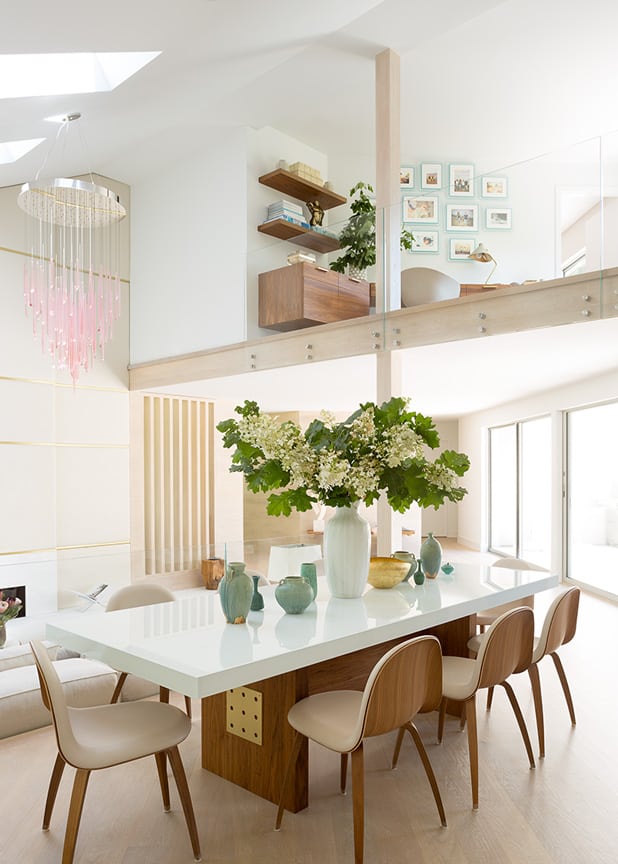The global health crisis has sparked a revolution in home of office design. Long considered an after-thought, home offices are now at the top of the list of architectural ’must-haves.’ In the Hamptons, where many residential work spaces were conceived for seasonal or part-time use, designers are creating high-end versions of remote workplaces that are nothing less than camera-ready. (Think Zoom meetings and virtual office cocktail parties.) At their best, these rooms combine function with comfort, glamour, and glorious views.
Daun Curry, who took the 2019 Andrew Martin International Interior Designer of the Year Award, talked to us about the remote workplace of today. Here are her tips for creating a stylish home office that you’ll never want to leave.

To begin with, give your screens a lift. People often park their computers on a stand or a desk. But for a more finished look, consider mounting your monitor or monitors on the wall. “We like to wall-mount whatever we can,” Curry says. “It saves a ton of space, plus it looks nice and tidy.”
On that note, think “sleek” rather than “geek”. For a home office that appears to float above the sunken living room of a home in East Hampton — the office occupies a mezzanine — Curry took inspiration from the shape of the space and designed a floating desk that includes ‘privacy panels’ for lamp cords, a laptop charging station, and a cell phone charger, all cleverly concealed. She also designed a set of floating cabinets mounted at a right angle to the desk so as to create an L-shaped work station. Above the cabinets, floating shelves hold plants and serve as display space for meaningful objects. The result is a work area that’s bright, airy, and sophisticated yet ultra-functional and organized, perfect for her clients, a financier and an executive recruiter.
“A floating desk isn’t a casual undertaking,” Curry admits. (It’s a fiddly installation process that involves opening up a wall.) “But the results are totally worth it.”
On the topic of cords, you’ll want to get wired like a pro. “Wire management is a big one,” says Curry, who advises clients to deal with the techno situation early on. “If you walk into a room and you see wires everywhere, the space will feel chaotic and cluttered, no matter how beautiful it may otherwise be. Wires should be integrated and that takes planning and care.”

Which brings us to storage. Suggests Curry, “Ask yourself at the outset what kind and how much storage space you’ll need. Not just for files, but for items like printers and telephones, which also have to be accounted for.” One visual trick is to store a printer inside a cabinet so that the office doesn’t look quite so office-y.
If you’re a creative person, you might not even need a desk, she says. “Before you do anything, ask yourself how and where you like to work. Maybe you like working on a bean bag half the day! Some people just want a big chair to sink into.” For those clients, Curry might create a work station along with a lounge-like seating area. She recommends leaving books and magazines on display, since she finds that when they’re out of sight, “you don’t reach for them.”
In terms of color, she is partial to soothing neutrals rather than bold primary shades that will only “distract from the task at hand.” And she likes to keep it light, as dark colors, she notes, “are more suited to a cozy night in” rather than tasks that require sustained focus.
As a final touch, Curry deploys live plants and flowers to create a feeling of general well-being. Accent pieces with soft edges and curvilinear shapes like those found in nature can create a similar effect. Do it right, and you just might forget you’re at the office.










!['The Maples' is a prestigious generational compound of two extraordinary estates: 18 Maple and 22 Maple. This rare offering, designed by luxury architect Lissoni partners New York and developed by visionaries Alessandro Zampedri-CFF Real Estate and JK Living, redefines opulence with the highest quality of craftsmanship and captivating views of the Atlantic Ocean. Represented by @nycsilversurfer and @challahbackgirl of @douglaselliman. [link in bio]](https://hamptonsrealestateshowcase.com/wp-content/uploads/sb-instagram-feed-images/438891010_1083749139481747_7890082604579275354_nfull.jpg)
![Featuring 360-degree water views on Mecox Bay, the Atlantic Ocean and Channel Pond, 1025 Flying Point offers the ultimate beach cottage that is flooded with natural light. With panoramic views, proximity to the ocean, and a private walkway to Mecox bay for kayaking or paddle boarding, this truly is a special retreat. Represented by @ritcheyhowe.realestate and @hollyhodderhamptons of @sothebysrealty. [link in bio]](https://hamptonsrealestateshowcase.com/wp-content/uploads/sb-instagram-feed-images/438994305_737511778456166_4602476013493875279_nfull.jpg)
![Attention advertisers! 📣 Secure your spot in the highly anticipated Memorial Day edition #HRES. Reach thousands of potential clients and showcase your brand in one of the most sought-after publications in the Hamptons, NYC, Palm Beach, and beyond. Contact us now to reserve your ad space! [link in bio]](https://hamptonsrealestateshowcase.com/wp-content/uploads/sb-instagram-feed-images/438549843_275102939023235_6718257301437562124_nfull.jpg)
![You eat with your eyes, and on the East End, it’s important that what you eat looks just as good as how it tastes. At @rosies.amagansett, the restaurant itself is plenty photo-worthy with blue ceramic tiling and yellow and white striped fabric wallpaper. But for a dish that will light up your photos, head directly to the salmon tartare! [link in bio]](https://hamptonsrealestateshowcase.com/wp-content/uploads/sb-instagram-feed-images/437094269_7296727147115953_1594410326824303644_nfull.jpg)

![We were honored to be the media sponsor for @blackmountaincapital's open house event with @jameskpeyton and @jfrangeskos at 11 Dering Lane in East Hampton! Other sponsors included @landrover, Feline Vodka, @rustikcakestudio, @la_parmigiana, @lahaciendamexicangrill11968, @homesteadwindows, Stone Castle, @talobuilders, and @thecorcorangroup.
A big thank you Carrie Brudner of Black Mountain Capital for putting together this fabulous event! [link in bio]](https://hamptonsrealestateshowcase.com/wp-content/uploads/sb-instagram-feed-images/437081213_762912965932136_6847332836522786568_nfull.jpg)

![Blooms Galore at the Long Island Tulip Festival! 🌷✨ Mark your calendars for April 15th as the vibrant tulips at @waterdrinkerlongisland burst into full bloom! Enjoy a day filled with colorful splendor, food trucks, live music, and more. [link in bio]](https://hamptonsrealestateshowcase.com/wp-content/uploads/sb-instagram-feed-images/437083429_974242677583725_6855805712693638343_nfull.jpg)
